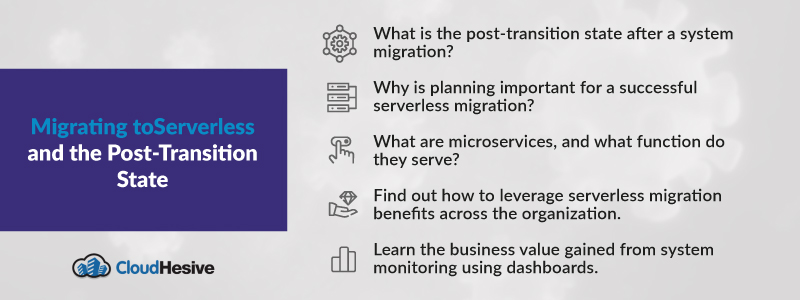Migrating to serverless and making it to post-transition successfully requires solid strategic planning. To get to the post-transition stage, an organization must understand how the system currently functions as a whole and the many integrated parts and processes involved. Understanding the existing system is the only way to properly plan to replace it with a minimum of work interruption or loss of productivity.

This guide provides tips for post-migration success to serverless, from including system monitoring to updating business processes and training.
What does the transition process entail?
The benefits of streamlined processes, reduced costs, and improved productivity are realized over time. Include planning time for retraining resources in the new workflow procedures and for establishing new work routines. Additionally, plan on implementing a system monitoring method that includes data presented in a dashboard view for more accurate and faster system analysis. System monitoring should include real-time alerting for errors as well as reporting on process efficiencies and cost projections.
Migrating to serverless and managing where your business lands post-transition requires understanding the serverless system and knowing what it impacts. Serverless software application development means altering business processes (including coding and deployment). Be prepared for the transition by planning out process differences and providing thorough training. Make the most of the agility and power of serverless by ensuring all business teams benefit from its advantages using system monitoring and real-time notifications for issues.
What is the post-transition state after a system migration?
The post-transition state after migrating to a serverless system isn’t without its difficulties. Most departments within the organization shouldn’t notice that the migration happened at all. IT or DevOps and the development, testing, and product teams are likely the only groups who feel the impact first-hand.
Once an organization’s system is up and running on a serverless architecture, development teams must retrain resources on coding practices and deployment differences. Additionally, testers must plan testing on a cloud or distributed system, which is different from testing on an on-premises server system. Product teams must understand the changes in the backend operations to provide more precise requirements and user stories when code is impacted by the serverless architecture setup. Training of resources in processes and new tools takes time. Expect some bumps and starts until the teams adjust to the new work processes.
What’s next? Continuous improvement. A serverless architecture provides a cyclical system that feeds into itself and creates a more seamless, smoother workflow process that allows higher-quality code to reach customers faster and more efficiently. Developers and other team members work continuously to improve the system flow. Tweaks and adjustments will need to be made to ensure all critical processes are functioning as required.
Teams within the organization will experience culture shifts. As part of the continuous improvement process, team members will adjust working habits and indicate where changes must be made to improve the functioning of the system. Application and system performance monitoring must be in place at the post-transition stage to ensure the business realizes the benefits and ROI of adopting the serverless architecture.
Part of continuous system monitoring is validating system security. Keeping applications and data safe is vital. In fact, 81% of teams in the post-transition state responded that security was the top challenge after a serverless migration. Employ continuous system monitor to ensure the entirety of the system remains secure. Keep in mind that the structure of a serverless system contains data on stakeholders, partners, and customers as part of its business data. This business data provides valuable information and insights to be competitive. Monitoring is essential to business data security.
Other benefits of serverless system monitoring include:
- Application processing execution for each event
- Issue and error management
- Team collaboration
- Application performance
- Continuous learning through quality tracking
Now that the end benefits are clear, what does the beginning of the process look like? It’s always necessary to have a plan.
Why is planning important for a successful serverless migration?
Migrating to a different architecture is never easy or inexpensive. Start the process with strategic and financial planning to best understand the risks and workarounds a successful migration requires. Planning improves the chances of a successful migration by unraveling complex, integrated, and intertwined applications and backend processes. Without a complete understanding of what’s involved through extensive planning, the migration stalls or fails, and significant rework results.
During planning, create a baseline of metrics produced by the initial system structure. Once the migration reaches the post-transition stage and is operating entirely on the serverless architecture, run the baseline metrics again. The baseline metrics provide an initial view of the state of the migration and may point to areas that need further review or monitoring for continuous improvement.
For example, baseline metrics may indicate that the application performance is under-provisioned. Baseline metrics are a handy and accurate method that reliably indicates where the serverless system can be altered to provide the benefits and ROI needed.
What are microservices, and what function do they serve?
One way to simplify the process is to use microservice functions during the early stage migration process. Microservices are used to reduce the amount of coupling between application flow paths. Essentially, developers use a microservice to replace individual server calls within the code. RESTful APIs are frequently used to efficiently process functions within the application only when needed.
Microservices are not typically part of a serverless architecture but are used to support an ongoing migration of existing applications over to a serverless system without disrupting the application functionality. In other words, microservices keep the system functioning normally until the migration is fully completed or you’ve reached the post-transition to a serverless cloud system milestone. Now that we’ve covered ground from the planning stage to the benefits, it’s time to ask if your business could make the switch.
Are you ready to migrate to serverless?
Keep in mind the advantages and risks of moving to a serverless architecture. Improvements in application performance, reduced business costs, and developer productivity need to be weighed over time for a realistic ROI. Serverless architecture provides a host of business-building benefits that enable software application development teams to build applications that are high quality, responsive, and capable of handling frequent release updates.
Considering migrating to an Amazon Web Services (AWS) serverless architecture? Have questions on what you need or how to proceed? CloudHesive provides support and deep expertise in using the AWS cloud and serverless architecture for the best business advantage. As an Amazon Managed Services partner, and Amazon Premier Partner, CloudHesive helps businesses take full advantage of all AWS features, including serverless architecture implementation and management. See what other customers have to say in case studies available from CloudHesive.



